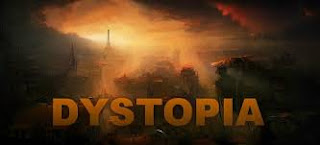Popular
Dystopias in Literature: An Overview
A dystopia is a vision of society, often
a future society, that is the opposite of paradise, or utopia. It is a vision
of society gone horribly wrong.
Nineteen Eighty-Four
bears some similarity to H. G. Wells’s dystopic When the Sleeper Wakes
(1899), in which the protagonist is transported into a world of technological
tyranny two hundred years into the future.
It has also often been pointed out that
in creating Nineteen Eighty-Four, Orwell drew on earlier dystopian novels.
 Indeed, Wells had been Orwell’s favorite
author when he was young. He shared not only Wells’s fascination with utopian
thinking but also his critical attitude toward the British class system.
Indeed, Wells had been Orwell’s favorite
author when he was young. He shared not only Wells’s fascination with utopian
thinking but also his critical attitude toward the British class system.
A more significant influence on Orwell’s
novel was probably We (1924), by Russian novelist Evgeny Zamyatin. In Zamyatin’s
dystopia, individuality has been all but obliterated; personal names have been
replaced by numbers; people’s lives are regulated down to the minutest details.
Those who do not conform are tortured
into submission by corrective brain treatment with X-rays, or publicly executed
by a chemical process that might be described as vaporization, the word used in
_Nineteen Eighty-Four_ about the sudden disappearance of unwanted persons.
Orwell reviewed Zamyatin’s novel in 1946 and found that it was a better novel
than Aldous Huxley’s Brave New World (1932) insofar as it
provided a more credible motive for the power elite to stay on top than Huxley
had done.
In Orwell’s view no totalitarian system
could exist without a ruling class motivated by power hunger, the wish to
exercise power over others and keep it at any cost.
Fahrenheit 451
(1953), by Ray Bradbury is a dystopian novel, in which the theme of
totalitarian suppression of the masses is reflected in the storyline, one which
includes burning of books (which are illegal) as the basis for the plot.
Gun, with Occasional Music
(1994), is a novel by Jonathan Lethem. Lethem blends science fiction and the
hardboiled detective genre in this novel set in a not-sodistant dystopian
future.
Brave New World (1932),
is a novel by Aldous Huxley. The dystopian classic is about a society happily
tranquilized by government-issued drugs.
Moscow 2042
(1986), is a novel by Vladimir Voinovich. Time travel reveals the bleak future
of the Soviet Union, in a dystopian parody written during the glasnost
(openness) period.
The Handmaid’s Tale:
Atwood turned to speculative fiction with her novel _The Handmaid’s Tale._ In
this work she created the dystopia of Gilead, a future America in which
fundamentalists have imposed dictatorial rule.
Here, in a world polluted by toxic
chemicals and nuclear radiation, most women are sterile; those who are able to
bear children are forced to become ‘‘Handmaids,’’ official breeders who enjoy
some privileges yet remain under constant surveillance. Almost all other women
have been deemed expendable, except those who embrace the repressive religious
hierarchy run by men. Although Atwood’s strong feminist beliefs were evident in
her previous novels, The Handmaid’s Tale is the first of
her works to be dominated by feminist concerns.
Anthony Burgess is a prolific British
novelist famous for the dystopian novel A Clockwork Orange (1962), set in a dystopian
society.
Brazil
(1985), is a dystopian a film directed by Terry Gilliam. This cult classic set
in a dull dystopia in the future features a hero who dreams of escape from a
mind-numbing bureaucratic job.
Anthem
(1938), is a novel by Ayn Rand. In this work the author presents a dystopian
(anti-utopian) society where socialism, or collectivism, rules.
Never Let Me Go,
written in 2005 by Japanese-born British author Kazuo Ishiguro, is also considered
a dystopian science fiction novel.
-
Gale/Routledge
Image courtesy: giftededucationcommunicator.com

Great to see the posts, Rufus.
ReplyDelete